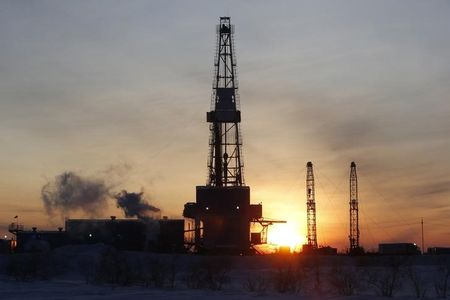Commodities
Oil prices settle higher to snap 2-week losing streak

Investing.com– Oil prices settled higher Friday, snapping a two-week losing streak after shrugging off dollar strength following in-line inflation data at a time when geopolitical tensions persist.
At 14:30 ET (19:30 GMT), rose 0.3% to $89.85 a barrel, while rose 0.4% to $89.38 a barrel.
PCE inflation rises in line with expectations
The dollar jumped as increased 0.3% last month, taking the 12-month figure through March to 2.7%, compared with economists’ estimates for a 2.6% rise.
The PCE price index is one of the inflation measures tracked by the U.S. central bank for its 2% target.
Signs of sticky inflation in the country have resulted in investors reining in expectations that the Federal Reserve will start cutting interest rates in the near future, even after softer-than-expected U.S. data released earlier this week.
Baker Hughes rig count falls by most since November
The number of oil rigs operating in the U.S. fell to 506 from 511, according to data Friday from energy services firm Baker Hughes, marking the biggest weekly decline since November.
The fall in rig count come even as data this week showed U.S. output remained steady at near record highs.
oil production in the week ended Apr. 19, was 13.1 million barrels per day, unchanged from the prior week.
Middle East risks persist
Prices rose in recent sessions as data showed overall U.S. shrank more than expected in the past week, indicating some tightness in global oil markets.
remove ads
.
Concerns over disruptions to Middle East supplies also remained in play as Israel stepped up its strikes against Gaza. While a war with Iran did not materialize, the Israel-Hamas conflict showed few signs of stopping.
The U.S. was also set to mobilize more military aid for Israel after President Joe Biden approved a bill earlier this week.
This kept some elements of risk premium in play for oil prices, helping them weather concerns of weaker demand and softening global growth.
Still, oil prices were trading well below five-month highs hit earlier in April, as a lack of immediate escalation in the Iran-Israel conflict saw traders price out some risk premium from crude.
(Peter Nurse, Ambar Warrick contributed to this article.)
Commodities
Oil prices rise; U.S. crude inventories plunge, Russia-Ukraine truce eyed
Commodities
India’s Reliance to stop buying Venezuelan oil over US tariffs, sources say
Commodities
Oil prices climb on Venezuela supply worries

 Forex3 years ago
Forex3 years agoForex Today: the dollar is gaining strength amid gloomy sentiment at the start of the Fed’s week

 Forex3 years ago
Forex3 years agoUnbiased review of Pocket Option broker

 Forex3 years ago
Forex3 years agoDollar to pound sterling exchange rate today: Pound plummeted to its lowest since 1985

 Forex3 years ago
Forex3 years agoHow is the Australian dollar doing today?

 Cryptocurrency3 years ago
Cryptocurrency3 years agoWhat happened in the crypto market – current events today

 World3 years ago
World3 years agoWhy are modern video games an art form?

 Commodities3 years ago
Commodities3 years agoCopper continues to fall in price on expectations of lower demand in China

 Economy3 years ago
Economy3 years agoCrude oil tankers double in price due to EU anti-Russian sanctions























